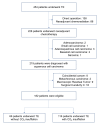Long-Term Outcomes of Carbon Dioxide Insufflation in Thoracoscopic Esophagectomy After Neoadjuvant Chemotherapy for Esophageal Squamous Cell Carcinoma: A Retrospective Cohort Study
- PMID: 39171044
- PMCID: PMC11335430
- DOI: 10.7759/cureus.65053
Long-Term Outcomes of Carbon Dioxide Insufflation in Thoracoscopic Esophagectomy After Neoadjuvant Chemotherapy for Esophageal Squamous Cell Carcinoma: A Retrospective Cohort Study
Abstract
Background: Thoracoscopic esophagectomy (TE) with carbon dioxide (CO2) insufflation is increasingly performed for esophageal cancer; however, there is limited evidence of the long-term outcomes of CO2 insufflation on postoperative survival.
Objectives: We investigated the long-term outcomes of TE with or without CO2 insufflation.
Methods: We enrolled 182 patients who underwent TE for esophageal cancer between January 2003 and October 2013 and categorized them into two groups: with and without CO2 insufflation. The primary endpoint was five-year overall survival (5y-OS). Secondary endpoints included long-term outcomes, such as five-year relapse-free survival (5y-RFS) and five-year cancer-specific survival (5y-CSS), and short-term outcomes, such as surgical and non-surgical complications and reoperation within 30 days.
Results: Follow-up until death or the five-year postoperative period was 98.9% (median follow-up duration was six years in survivors). After adjusting for age, sex, and yield pathologic tumor, node, and metastasis (TNM) stage, we found no significant differences in 5y-OS (HR 1.12, 95% CI 0.66-1.91), 5y-RFS (HR 1.12, 95% CI 0.67-1.83), or 5y-CSS rates (HR 1.00, 95% CI 0.57-1.75). For short-term outcomes, significant intergroup differences in operation time (p=0.02), blood loss (p<0.001), postoperative length of stay (p<0.001), and incidence of atelectasis (p=0.004) were observed. The results of the sensitivity analysis were similar to the main results.
Conclusions: In thoracoscopic procedures, CO2 insufflation significantly improved short-term outcomes, and it appears that the recurrence risk of esophageal cancer may not impact the long-term prognosis. While the influence of CO2 insufflation in thoracoscopic esophageal surgery remains unclear, our study suggests that the long-term prognosis is not compromised in other thoracic surgeries.
Keywords: carbon dioxide insufflation; esophageal cancer surgery; long-term prognosis; overall survival (os); thoracoscopic esophagectomy.
Copyright © 2024, Otsuka et al.
Conflict of interest statement
Human subjects: Consent was obtained or waived by all participants in this study. Institutional Review Board of Showa University School of Medicine issued approval 2256. Animal subjects: All authors have confirmed that this study did not involve animal subjects or tissue. Conflicts of interest: In compliance with the ICMJE uniform disclosure form, all authors declare the following: Payment/services info: All authors have declared that no financial support was received from any organization for the submitted work. Financial relationships: All authors have declared that they have no financial relationships at present or within the previous three years with any organizations that might have an interest in the submitted work. Other relationships: All authors have declared that there are no other relationships or activities that could appear to have influenced the submitted work.
Figures



Similar articles
-
Efficacy of CO2 insufflation during thoracoscopic esophagectomy in the left lateral position.Gen Thorac Cardiovasc Surg. 2017 Oct;65(10):587-593. doi: 10.1007/s11748-017-0816-7. Epub 2017 Aug 21. Gen Thorac Cardiovasc Surg. 2017. PMID: 28828555
-
Impact of artificial capnothorax on coagulation in patients during video-assisted thoracoscopic esophagectomy for squamous cell carcinoma.Surg Endosc. 2016 Jul;30(7):2766-72. doi: 10.1007/s00464-015-4549-3. Epub 2015 Nov 12. Surg Endosc. 2016. PMID: 26563508 Clinical Trial.
-
Investigation of operative outcomes of thoracoscopic esophagectomy after triplet chemotherapy with docetaxel, cisplatin, and 5-fluorouracil for advanced esophageal squamous cell carcinoma.Surg Endosc. 2018 Jan;32(1):391-399. doi: 10.1007/s00464-017-5688-5. Epub 2017 Jun 29. Surg Endosc. 2018. PMID: 28664431
-
Effect of perioperative flurbiprofen axetil on long-term survival of patients with esophageal carcinoma who underwent thoracoscopic esophagectomy: A retrospective study.J Surg Oncol. 2021 Sep;124(4):540-550. doi: 10.1002/jso.26553. Epub 2021 Jun 18. J Surg Oncol. 2021. PMID: 34143443 Free PMC article.
-
[Clinical application and analysis of single-port laparoscopic and thoracoscopic McKeown esophagectomy for esophageal cancer].Zhonghua Yi Xue Za Zhi. 2021 Aug 3;101(29):2316-2321. doi: 10.3760/cma.j.cn112137-20201215-03359. Zhonghua Yi Xue Za Zhi. 2021. PMID: 34333948 Chinese.
References
-
- Global cancer statistics 2018: GLOBOCAN estimates of incidence and mortality worldwide for 36 cancers in 185 countries. Bray F, Ferlay J, Soerjomataram I, Siegel RL, Torre LA, Jemal A. CA Cancer J Clin. 2018;68:394–424. - PubMed
-
- Endoscopic ultrasonic dissection for thoracoscopic and laparoscopic surgery. Cuschieri A, Shimi S, Banting S, Vander Velpen G. Surg Endosc. 1993;7:197–199. - PubMed
-
- Thoracoscopic subtotal oesophagectomy. Cuschieri A. https://pubmed.ncbi.nlm.nih.gov/8081911/ Endosc Surg Allied Technol. 1994;2:21–25. - PubMed
-
- Prolonged pneumoperitoneum time is an independent risk factor for intravesical recurrence after laparoscopic radical nephroureterectomy in upper tract urothelial carcinoma. Shigeta K, Kikuchi E, Hagiwara M, et al. Surg Oncol. 2017;26:73–79. - PubMed
-
- CO2 environment influences the growth of cultured human cancer cells dependent on insufflation pressure. Gutt CN, Kim ZG, Hollander D, Bruttel T, Lorenz M. Surg Endosc. 2001;15:314–318. - PubMed
LinkOut - more resources
Full Text Sources
